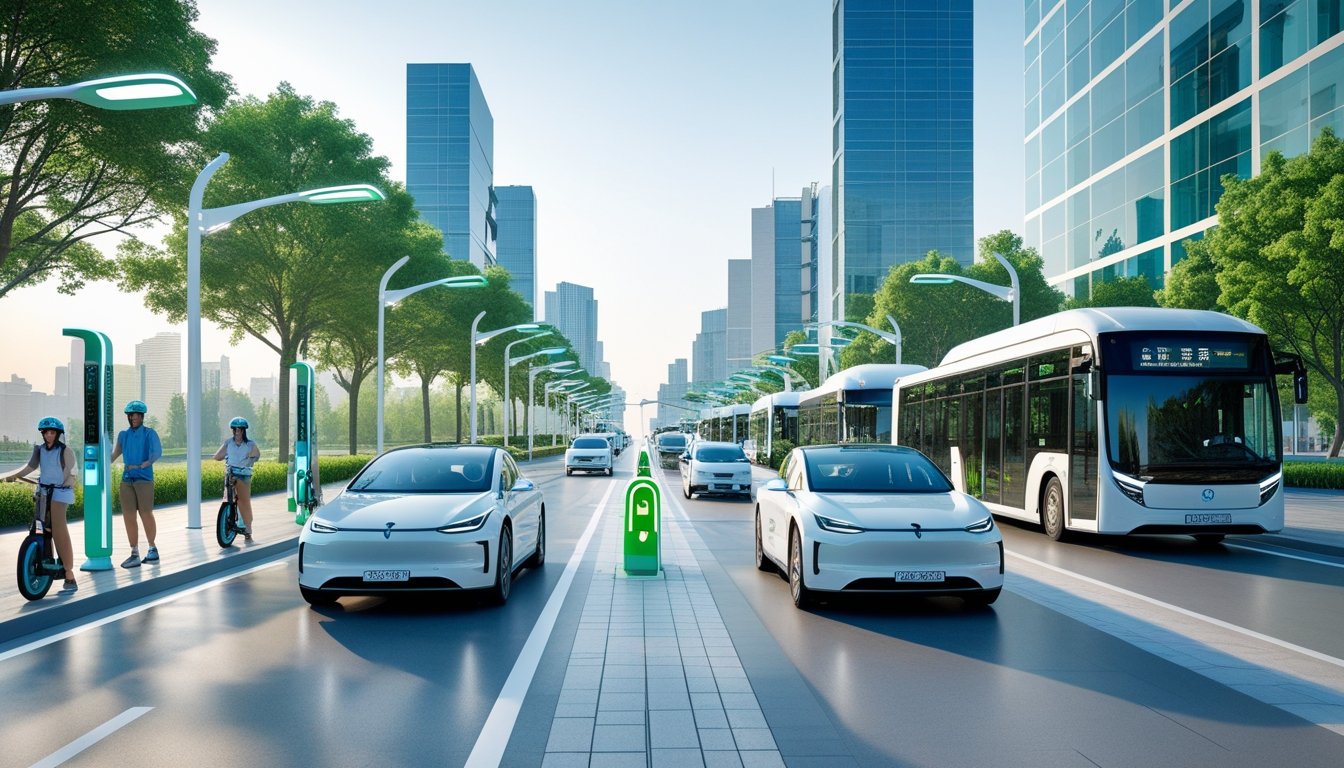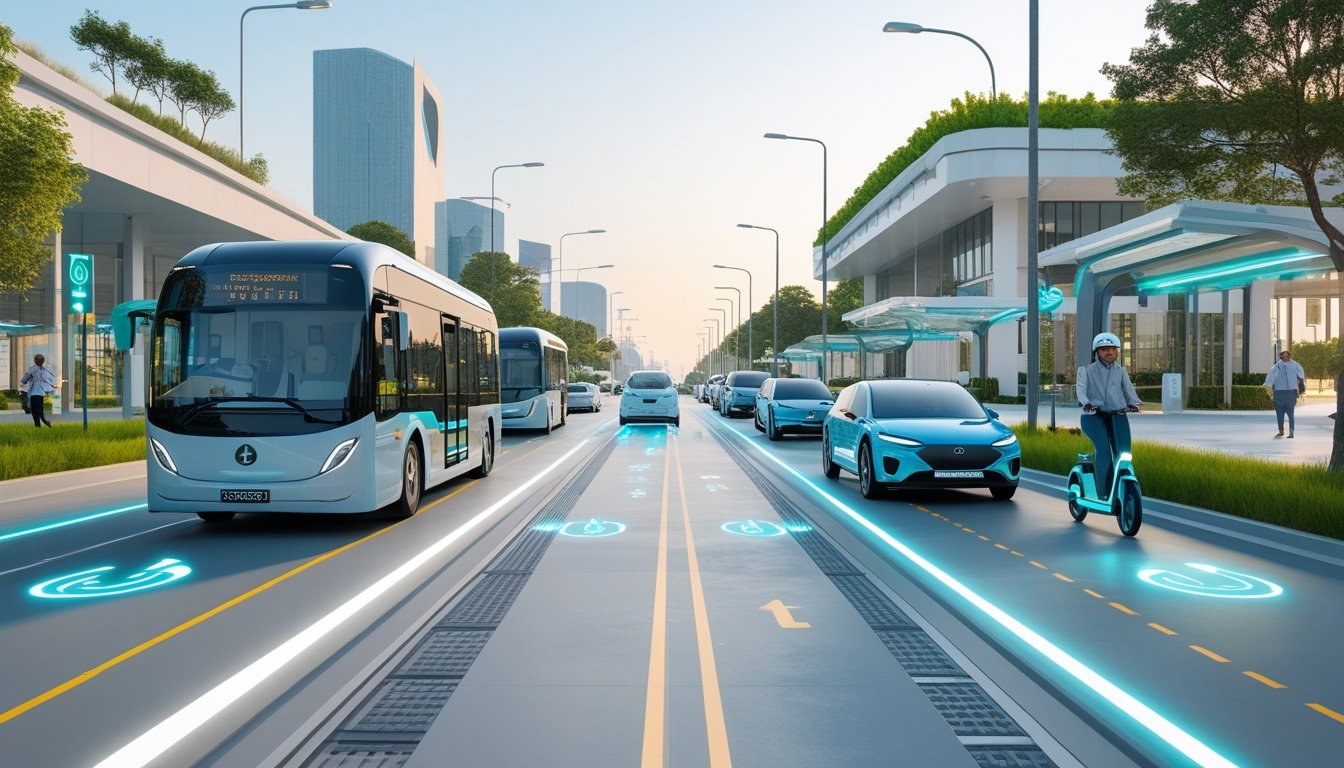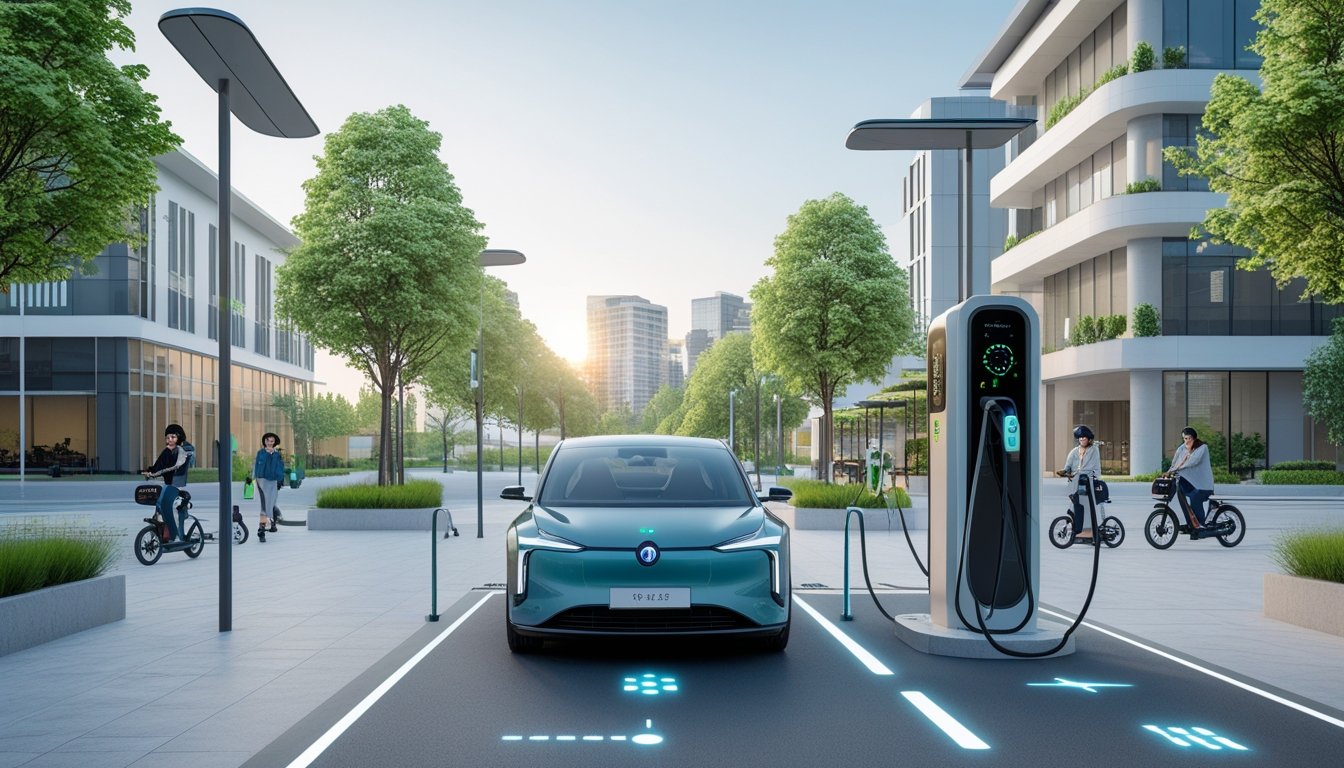Late updated: 27 Jul 2025 16:07
Written by: Amber Collins
Electric Vehicles And The Future Of Urban Transport: Transforming City Mobility
Electric vehicles (EVs) are rapidly redefining the landscape of urban transport, ushering in an era of cleaner, quieter, and more efficient cities. By integrating electric mobility into urban planning, we are promoting sustainable development and addressing pressing environmental issues. As the momentum for EV adoption grows, so too does the need for cities to adapt their infrastructure and policies to accommodate this transformative shift.

As we embrace this change, we see burgeoning opportunities in the convergence of technology, infrastructure, and sustainability. Smart cities are emerging as leaders in efficient traffic management, showcasing the benefits of EVs through reduced emissions and improved air quality. With ongoing advancements in battery technology and renewable energy integration, the future of urban mobility looks promisingly green.
The transition is not without its challenges, but the potential benefits to urban living are immense. EVs offer not just an answer to pollution concerns but also a pathway to better connectivity and enhanced public transport systems. As we continue on this journey, it's essential for governments, industries, and communities to collaborate, ensuring that this transition is seamless and inclusive.
Key Takeaways
- Electric vehicles are transforming urban transport and sustainability.
- Smart cities are enhancing infrastructure for efficient EV integration.
- Collaboration is key to overcoming challenges in urban mobility evolution.
Electric Vehicles Shaping Urban Mobility
Electric vehicles (EVs) are at the heart of innovative urban mobility solutions. By transforming traditional transportation methods, they offer cleaner, quieter, and more sustainable options for city transit systems. Each mode of transport, from buses to scooters, plays a pivotal role in the future of sustainable urban mobility.
The Role of Electric Buses and Bus Fleets
Electric buses are revolutionising public transport by reducing emissions and noise pollution. They offer an efficient alternative for urban areas increasingly focused on sustainability. Cities around the globe are adopting electric bus fleets to replace diesel vehicles, leading to improved air quality.
Investing in electric bus infrastructure is crucial. Charging stations at bus depots and along routes ensure minimal downtime. This allows for continuous operation, significantly enhancing the reliability of public transport networks.
Key benefits include reduced operational costs and government incentives. Cities are exploring partnerships with manufacturers to expedite fleet electrification. Electric buses are not just vehicles; they are vital components of future-forward urban transport systems.
Electrifying Taxis, Ride-Sharing, and On-Demand Services
Traditional taxis and ride-sharing services are undergoing a significant transformation. Electrifying these fleets contributes heavily to emission reduction goals. As urban areas push for greener transport, electric taxis offer a viable solution.
Economically, electric taxis are becoming more appealing to drivers and operators. Reduced fuel costs and maintenance expenses make EVs an attractive choice. Ride-sharing platforms are also integrating EVs into their services, encouraging drivers to switch.
Policies promoting EV adoption are crucial. Cities are incentivising on-demand services to provide clean, efficient transport. The integration of electric taxis ensures urban mobility is not only sustainable but also adaptable to future demands.
Microtransit, Electric Scooters, and Bike-Sharing
Microtransit, electric scooters, and bike-sharing schemes are reshaping how we navigate urban environments. These solutions fill gaps in public transport networks, offering flexible, convenient mobility for short distances.
Electric scooters and bikes enhance last-mile connectivity. They provide eco-friendly alternatives to private cars, thereby easing traffic congestion. Accessibility and affordability are their main advantages. These modes support healthy, active lifestyles while reducing the carbon footprint.
Cities are investing in infrastructure to integrate these options. Bike lanes and docking stations enhance safety and ease of use. The synergy of microtransit with public transport systems is a step forward in creating efficient urban mobility strategies.
Zero-Emission Zones and Urban Mobility Solutions
Zero-emission zones (ZEZs) are powerful tools in the transition to sustainable cities. By restricting polluting vehicles, they encourage the adoption of clean transport solutions. This includes electric buses, taxis, and microtransit options, ensuring urban air quality trends positively.
ZEZs are designed to limit exhaust emissions in specific areas, such as city centres. Public policy plays a significant role in their implementation, offering incentives for EV usage and penalising traditional vehicles.
The enforcement of ZEZs encourages innovation in urban mobility solutions. These zones catalyse the growth of infrastructure and green technology, setting a framework for sustainable transport development. By prioritising zero emissions in urban spaces, cities can move towards a cleaner, more efficient future.
Infrastructure, Technology, and Sustainability in Electric Urban Transport

In the evolving landscape of electric urban transport, infrastructure and technology advancements are central to achieving sustainability. Critical aspects include robust charging solutions, integration with the grid, battery enhancements, and tangible environmental benefits.
Charging Networks, Public Charging Stations, and Fast-Charging Solutions
Developing comprehensive charging networks is fundamental to supporting electric vehicle (EV) adoption. Accessible public charging stations are crucial for city dwellers who may lack private charging options. Fast-charging solutions are being deployed to minimise wait times and increase convenience.
Public charging stations are strategically placed in urban centres, retail locations, and along busy highways to cater to various user needs. Fast-charging networks, offering rapid energy replenishment, are continuously expanding, ensuring EVs can be conveniently charged during short stops.
Smart Charging, Grid Integration, and Vehicle-to-Grid Innovations
Smart charging solutions optimise the use of electricity by aligning charging activities with periods of lower demand or greater renewable energy availability. These smart solutions are vital for maximising efficiency and maintaining grid stability.
Grid integration enables vehicle-to-grid (V2G) technology, where EVs can return power to the grid during peak demand, effectively transforming EVs into mobile energy storage units. Innovations in V2G offer promising benefits, including energy cost savings and enhanced grid resilience.
Battery Technology, Clean Energy, and Renewable Integration
Advancements in battery technology are key to enhancing EV range, performance, and sustainability. We are seeing significant improvements in battery capacity and charging speeds, making EVs more competitive with traditional vehicles.
Clean energy adoption in the charging process further bolsters the environmental profile of EVs. Integrating renewable energy sources such as solar and wind into charging networks not only reduces reliance on fossil fuels but also supports climate change mitigation efforts.
Environmental Benefits, Air Quality, and Noise Reduction
By replacing combustion engines with electric drivetrains, EVs contribute significantly to reducing air pollution. Reduced tailpipe emissions and decreased reliance on fossil fuels benefit public health by improving urban air quality.
Noise pollution is another area where EVs excel. The quieter operation of electric motors leads to less noisy urban environments, which can reduce stress levels and improve the quality of life for city inhabitants. These environmental benefits position EVs as central to sustainable urban transport.
EV Adoption, Financial Incentives, and Global Case Studies
Accelerating EV adoption is closely tied to financial incentives and policy initiatives. Urban centres worldwide, such as Amsterdam, provide subsidies and tax benefits to encourage EV uptake and support infrastructure development.
Case studies from cities with successful EV adoption strategies illustrate the importance of these incentives in promoting sustainable urban transport solutions. By investing in infrastructure and policy measures, cities can significantly transform their transport landscapes, reduce emissions, and improve environmental outcomes.
Frequently Asked Questions

We examine the infrastructure needed for electric vehicles (EVs) in urban spaces, their environmental impact, and economic implications for public transport. We also consider how cities can promote EV usage and discuss challenges and advancements such as autonomous vehicles.
What infrastructure is required to support the widespread adoption of electric vehicles in urban areas?
Urban areas need a comprehensive charging infrastructure. This includes accessible, fast-charging stations located at strategic points. Upgrading power grids to handle increased demand is crucial. The integration of smart technology can optimise charging and ensure efficient energy use.
How do electric vehicles contribute to the reduction of carbon emissions in city environments?
Electric vehicles emit no tailpipe pollutants, leading to cleaner air in cities. By replacing combustion engine vehicles with EVs, urban areas can significantly reduce their carbon footprint. When powered by renewable energy, their environmental benefit is maximised.
What are the economic implications of transitioning to electric vehicles for urban public transport systems?
Switching to electric buses and taxis can lower operational costs due to less expensive fuel and maintenance. Initial investments can be high, but long-term savings, coupled with government incentives, make the transition economically viable for most urban transport systems.
How can cities incentivise the adoption of electric vehicles amongst residents?
Cities can encourage EV adoption through financial incentives like tax breaks and subsidies for EV purchases. Implementing policies such as free parking for EVs and reduced road charges can also attract more citizens to choose electric. Expanding charging infrastructure is another key component.
What are the most significant barriers to the integration of electric vehicles into existing urban transport networks?
Key challenges include the high upfront costs of EVs and the limited charging infrastructure. Range anxiety, or fear of running out of power without a charging station nearby, also affects adoption. Overcoming these barriers requires coordinated efforts between government, industry, and citizens.
How is the development of autonomous electric vehicles expected to impact urban transport strategies?
Autonomous electric vehicles promise to revolutionise urban transport by reducing accidents and easing congestion. They may lead to changes in traffic management and public transport planning. However, cities will need robust regulatory frameworks to ensure their safe and efficient integration.
